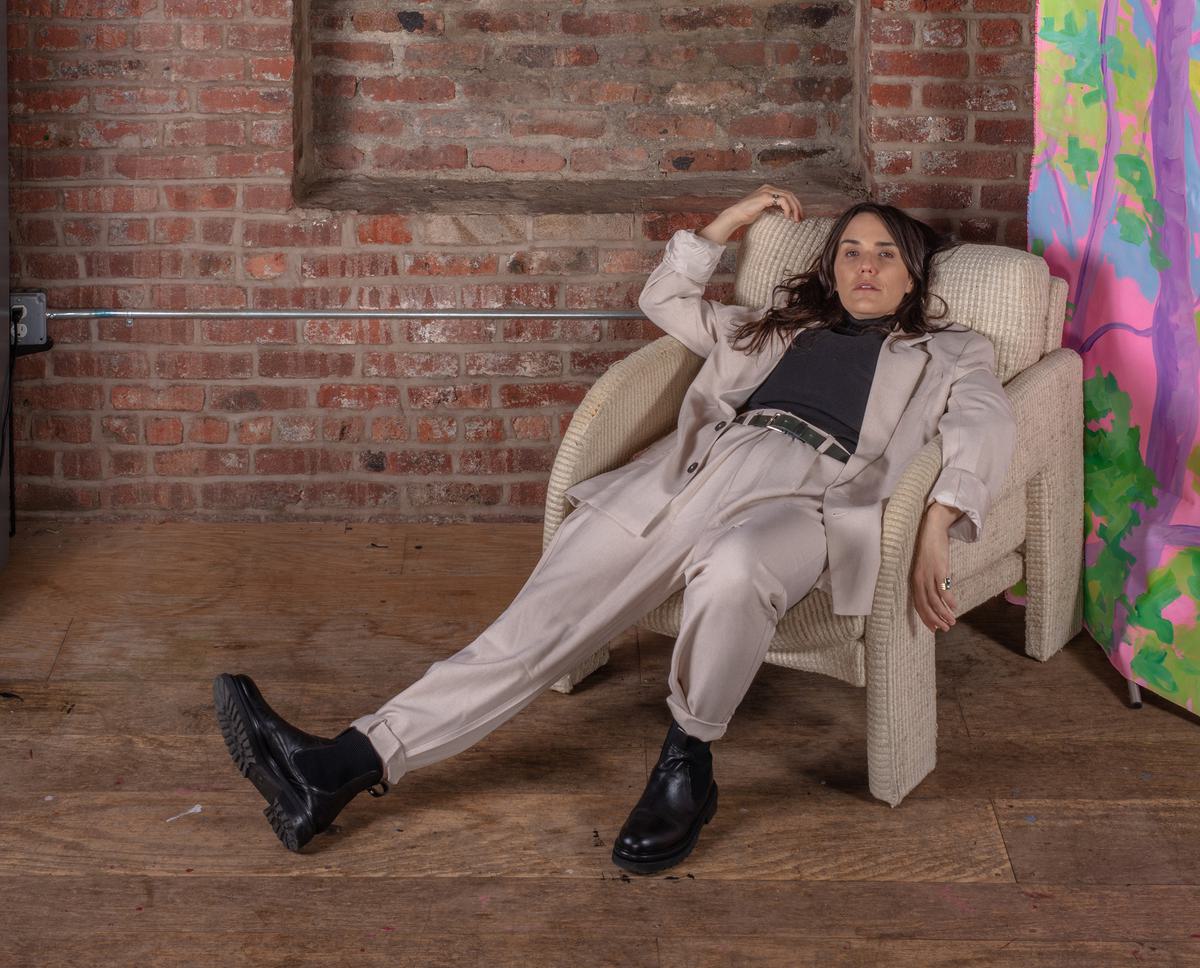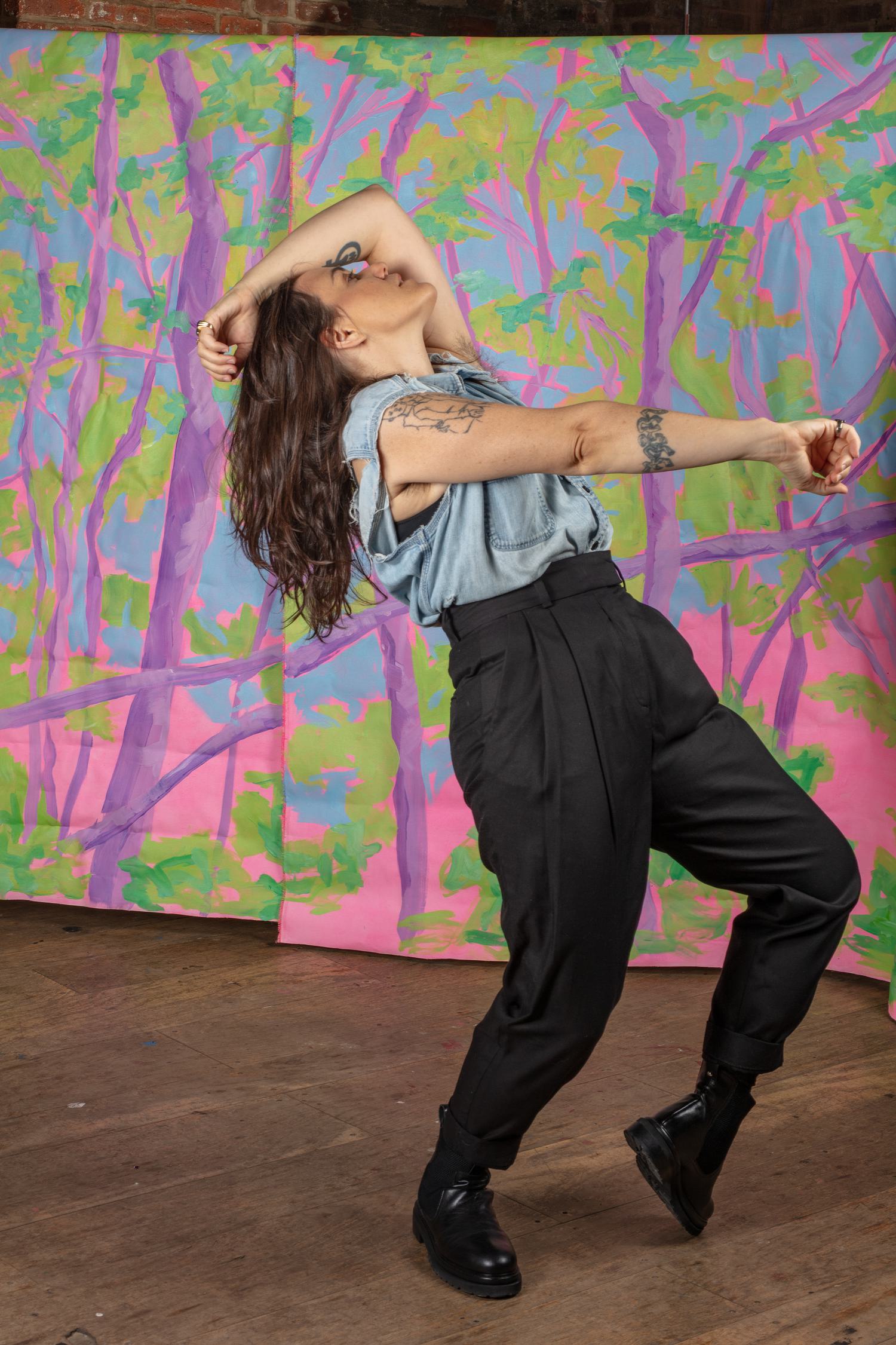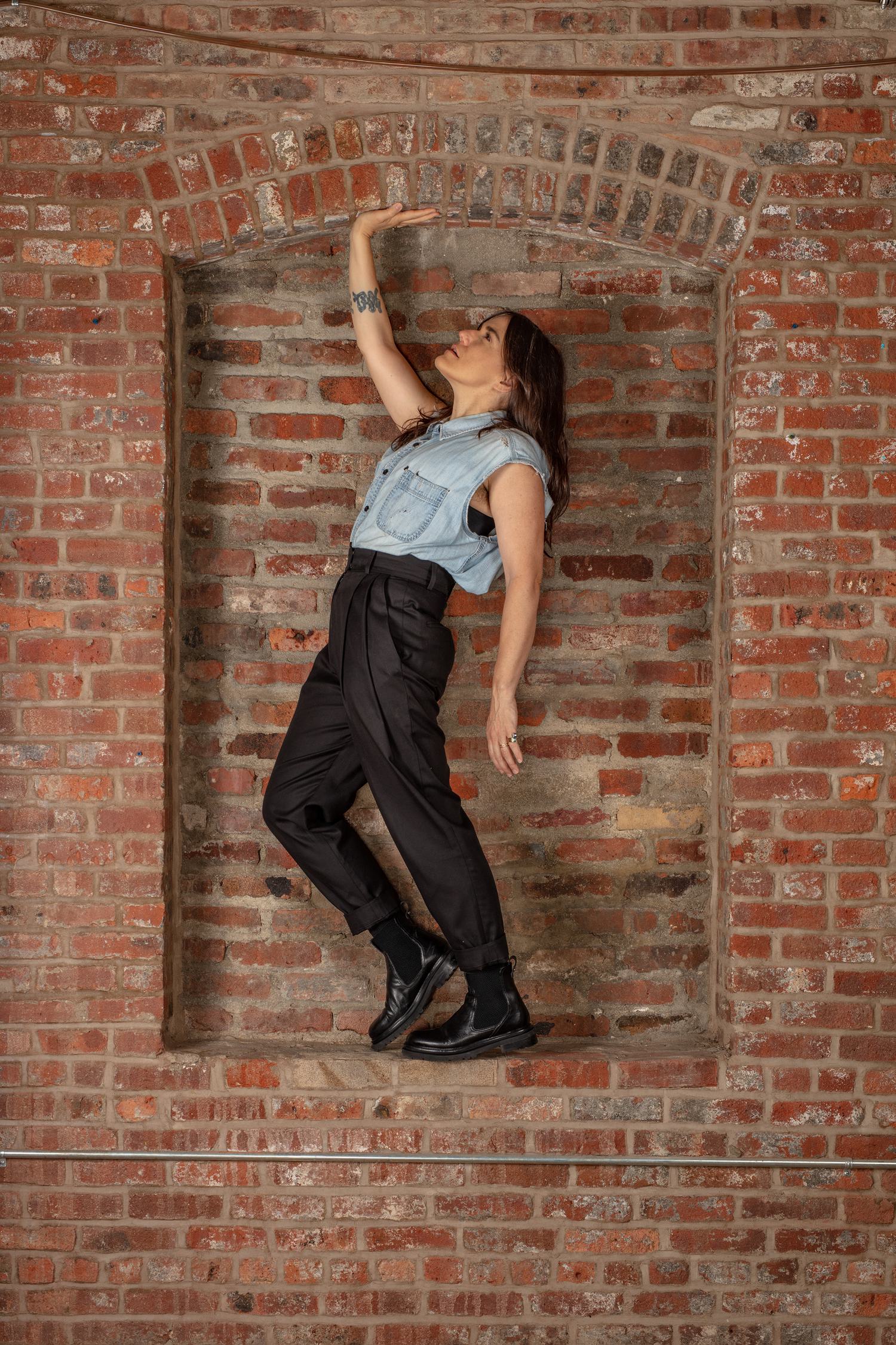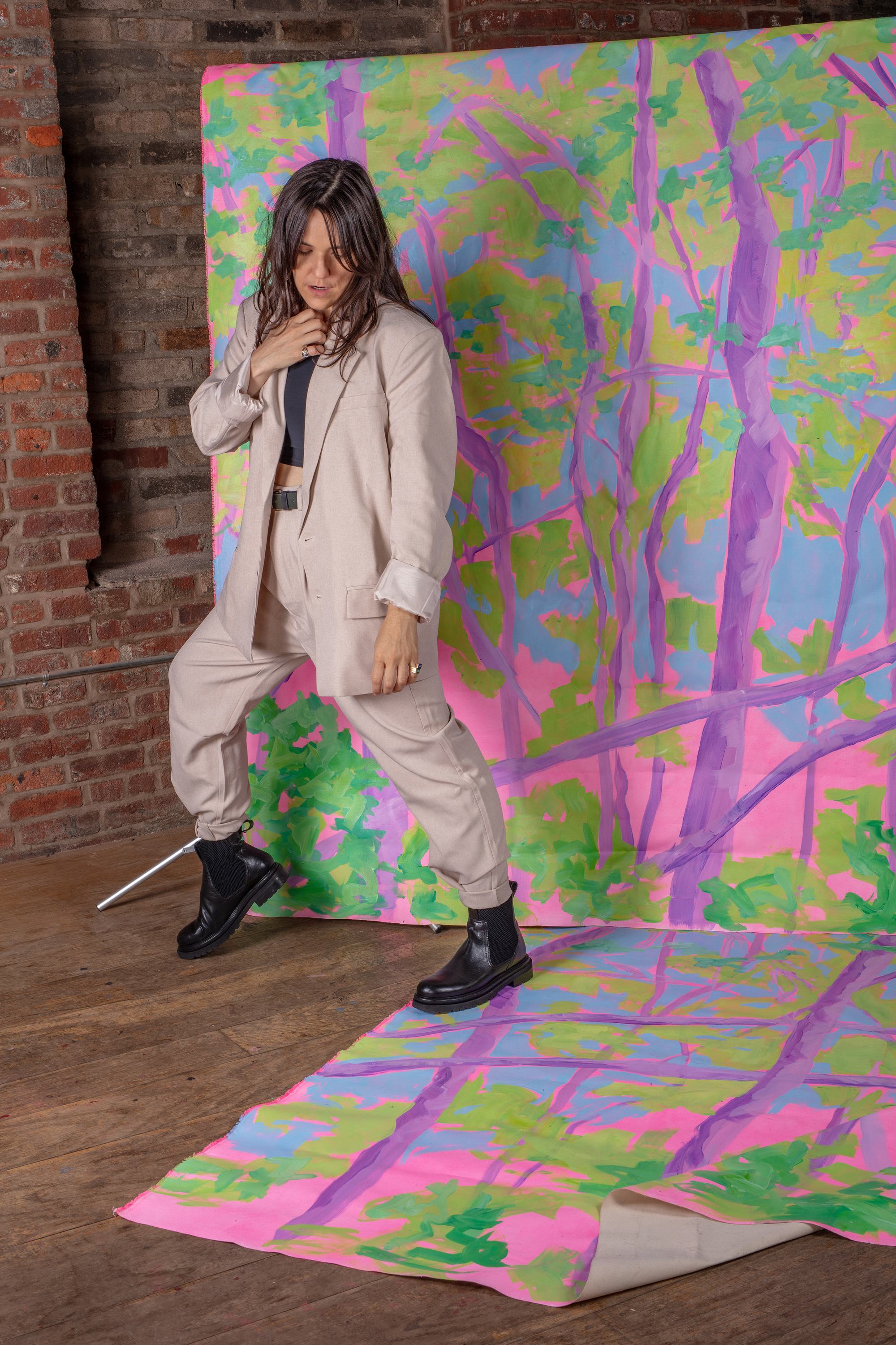
Emily Wells and the Art of Acting Up
Emily Wells kicks off the European leg of her Regards to the End tour this week. She talks to Alan Pedder about how the climate crisis and the history of HIV/AIDS activism continues to inform her work.
Four years ago, early one Saturday morning, well-known LGBT rights lawyer and conservationist David Buckel walked out into the park near his Brooklyn home, laid a circle of soil around him, then kneeled down in the centre and set himself on fire.
His suicide note, left in a shopping cart next to his remains, linked his violent death by fossil fuel to the slow death of our planet by the same means. Buckel’s intentions were clear. In his note, which he emailed to the media just moments before he doused himself in petrol, he hoped his final act would lead to mass mobilisation on the climate crisis.
But the needle on the dial barely moved. Not in the immediate aftermath, not later. Buckel’s death, though very public, was also strangely out of sight. To quote the title of a New York Times op-ed that ran just a few days after the fact, “A Man Set Himself on Fire. We Barely Noticed.”
One person who did notice was musical polymath Emily Wells, who was living in the city at the time. “It was one of those events that are somehow non-events in New York,” she tells me over the phone from where she lives now, just outside of Philadelphia with her artist girlfriend Samantha Nye. “A lot of people didn’t even realise that it happened, but I was so struck by it. It caused a lot of grief and thinking on my end.”
Wells had been working on a song at the time, inspired in part by the worsening wildfires season out west. She’d been toying with the idea that fire is something we all carry around inside, and that just existing makes us in some way complicit with burning the world around us. But as she learned more about Buckel’s life and his noble, terrible death, she started to consider extinguishing that fire not as ‘just’ a suicide but as a radical act of compassion.
The fate of the planet is not a new topic for Wells. Climate breakdown has been at the centre of her work for over five years now, not only in her music but also in her poetic and powerful video art. Used in the video for 2019’s “Come on Doom, Let’s Party” and as a backdrop to her live shows, Wells’ films make striking connections between found footage of contemporary dance, extreme weather events, and the ACT UP protests of the ‘80s, which demanded political action on HIV/AIDS.
Compiling the footage, Wells was struck by the visual similarities between the three distinct threads she was pulling at. Noticing how the physical movements of the protestors would sometimes mirror the movements of the dancers, which would sometimes mirror the movements of natural disasters, she realised she was on to something she could make another body of work from. But it all felt a bit too grim, a bit too overwhelming.
“I was sort of wrestling with how to talk about it,” she admits. “But ACT UP really had something interesting going on, and I felt like there was a relationship there that I needed to get at.”

Though she says she can’t pinpoint the exact mechanism, thinking about David Buckel’s sacrifice somehow pulled her research into focus. She finished the song she had been working on, gave it the bittersweet title of “Love Saves the Day”, and set about laying the groundwork for Regards to the End.
And then the Covid pandemic arrived, adding an urgent, additional thread to her thoughts, reordering everything she had been thinking about. “I was like, ‘How do I talk about this stuff now? How do I be alone with these scary, big ideas?’”
Like many of us, shut behind our own doors for weeks or months at a time, Wells turned to the arts for solace and answers. Immersing herself in the work that artists were making in the early years of the HIV/AIDS epidemic, she found herself developing a common language with many of them. Important figures like writer, filmmaker and visual artist David Wojnarowicz, neo-conceptual text-based artist Jenny Holzer, and sculptor and printmaker Kiki Smith, to name just a few.
“They became almost like friends to me during the lockdowns,” she says. “It felt like I was having conversations with them about their work. How they made it. What they were thinking when they made it. What they were raging about. And how they were just getting through the loss, you know?”
Wells says she has often turned to literature and other writing when feeling stuck in the studio or needing to get out of her own head, but it’s only in the past few years that she’s really grasped how powerful those sources can be. “In a way, the record took a different form than the one I’d initially conceived and just became this conversation with all these people,” she adds. “But the central questions remained.”
Released in February this year, Regards to the End is a complex, deeply involved work loaded with tenderness and grief for what’s been lost and what we as a people still stand to lose. There’s a thinning of the veil feel to the album, not only in the way that Wells frames her songs of ghosts and lovers but also in the way that she uses breath and texture to bring them to life.
Wells’ instinct for writing in movements has always been her strength, giving her songs a compelling sense of dialogue and theatre. On Regards to the End, that instinct feels sharper than ever. The album’s secret weapon is in its sinuous, often epiphanic use of woodwinds. They’re there in the mazy, meticulous instrumentals of “Love Saves the Day” and in the breathtaking swells that mushroom up in the final third of the synth-driven “Two Dogs Tethered Inside” – just two of many wow moments here. The level of detail and skill is outstanding.
On stage, Wells has a reputation as a one-woman orchestra, often playing drums, keys, strings, guitar and more, all in the same show. A violinist from the age of four, she put together her first tape of songs by the age of 13 and just kept going from there. Having learned practice and discipline through the Suzuki method, she taught herself how to arrange, produce and mix her own music, self-releasing multiple albums from her late teens to her mid-twenties.
After two more releases on small independent labels, Wells made a splash with 2012’s Mama, the first of her albums to get a worldwide distribution. Interweaving chamber pop, hip hop and folk, it was a breath of fresh air underpinned by a startling musicality and her luminous, shapeshifting voice.
In the ten years since, she’s gradually drifted away from her more overt hip hop influences and towards an increasingly distinct brand of art-pop. Following 2016’s Promise, an ambitious gospel-folk treatise on struggle, partly inspired by modern dance pioneer Pina Bausch, Wells began to focus more closely on the threat of ecological destruction in her songs.
“It kind of stopped being a choice for me,” she said when premiering her next work, the climate-focused This World is Too _____ For You. “There was no luxury about what I get to make art about anymore. I really needed to think about ways to discuss these ideas.”
Commissioned by Liquid Music to work with violinist/composer Michi Wiancko, who arranged her songs for chamber ensemble, and percussionist Greg Fox, Wells’ approach was to write not directly about climate change but about the emotions surrounding it. An unintended consequence was that songs like “I Need a Placebo” and “Come on Doom, Let’s Party” took on whole new meanings during the pandemic. “The lyrics are almost hilarious in how relatable they were to life in lockdown,” she says.
Undeterred, Wells uses a similar approach on Regards to the End, writing about responses to events in her research rather than the events themselves. One lodestar in that respect was Olivia Laing’s 2016 book The Lonely City, a biography-slash-memoir about what we can learn about loneliness from art and its creators. Laing’s chapter on David Wojnarowicz turned out to a major jumping off point for Wells, who was so inspired by the author’s vivid portrait of him that she wrote “David’s Got a Problem” immediately after reading it.
“I had encountered Wojnarowicz before and had read his book, Close to the Knives, but that chapter on him really blew my mind,” she says. “Laing’s book in general was a huge influence. Her way of engaging with the artists felt really relatable to me. And the way she wrote it down so concretely made me feel like it could be a part of the work in a way that I could trust.”
“David’s Got a Problem” was the second song Wells wrote for the album, after “Love Saves the Day”, and she says it helped to guide her into the rest of the songs. Accordingly, Wojnarowicz is rarely far out of the frame across the other eight tracks. While recording album closer “Blood Brother”, Wells says she was singing to “a little Xerox self-portrait” of the artist that sits on the piano in her studio, while the yearning “Come On Kiki” was directly inspired by a scene from Wojnarowicz’s own life.
Writing in his diary shortly after a memorial for his lover Peter Hujar in November 1987, Wojnarowicz describes going back to Hujar’s apartment with Kiki Smith and trying to make sense of his passing. As Wells describes it, “They try to dance as a way of freeing his spirit and helping him to pass on, kind of like a ritual. At first they try to do this really awkward, stilted waltz but then they eventually free themselves of each other and their awkwardness and just become limbs. The way it’s described makes it feel as if you’re right there in the room, as Wojnarowicz’s writing often does, and it really moved me.”
Rather than writing “Come On Kiki” as an imagined conversation between the two artists, Wells took a more interesting route in writing about her own response to reading those passages, turning the song into more of a conversation between Smith and herself. “I felt like she was almost like a guide to Wojnarowicz in the ways in which she was leading him through that experience,” Wells explains. “So I kind of gave myself over to her in that way as well.”
In writing the song, Wells says she was thinking about her own physicality in the moment as well as the physicality of Smith’s work, particularly the bronze sculpture Tied to Her Nature. Currently in the collection of the Whitney Museum of American Art, it depicts a person tied to the underside of a goat. “I became interested in the ways in which we are tied to the natural world, against our will or otherwise, and I feel like Kiki Smith’s work really evokes that for me,” she says.
Across the album, there’s a recurring motif of constraints both submitted to and broken. It’s in “Come On Kiki”, of course, but also in “David’s Got a Problem” (“Tie a cord and hold me down”) and in “Two Dogs Tethered Inside” (“Where do I run when I run, run unhooked?”). Although Wells says that any thread between the songs was unintended, she acknowledges that she kept coming back to the idea of the duality between being domesticated and being wild at heart.
She points to the “The Dress Rehearsal” as another example. Partly inspired by regular encounters with a fox that lived in the woods by her home, where she would take long walks in the first months of the new pandemic, the song explores how we as individuals have become so separated from our animal nature.
“I started thinking about how the fox outside knows how to be immortal, in the sense of knowing how to renew itself and to be a fox always,” she explains. “Walking around, I could feel the woods coming to life in a way that was so clear, and in a way that knew exactly how to be, whereas I felt like I did not know how to be at all.”
"I’m really interested in the ways in which making art can address fears and be a way of working out those knotty feelings.”
“Two Dogs Tethered Inside” is not, despite its title, a version of the ‘inside each of us is two wolves’ proverb-turned-meme but a reflection on the last US election. “It was a really scary moment,” she recalls. “I feel like I saw certain darkness on the night of the election, when we were all on edge, but when I woke up the next day there was this new hope. It kind of felt like the tether had been cut a little bit, and then it was like, well, what are we going to do with that freedom? Do we stay within the boundaries we’re used to, or do we break through them?”
That idea of disrupting the status quo also comes through in “All Burn, No Bridge”, which was written in the context of the Black Lives Matter protests of May 2020 and contains the lyrics that gives the album its name. “I think that song is definitely touching on my own privilege and complicity,” says Wells. “Not just in terms of BLM, but in my participation in capitalist America and all that entails. It’s an attempt to just stand and be present in that knowledge. To really look and hear, instead of trying to atone or be forgiven. It’s also just about being enraged about the painful reality that we were standing in then, and that we continue to stand in.”
“I’m Numbers” was another song that came out of that spring, written as Wells was grappling with the way the world just changed on a dime when Covid really hit. Like many of us, she says she was completely obsessed with the number of cases and deaths being reported, “but also so repelled by the kind of sterilised, non-human way in which we were taking all that information in.”
Noting the similarities with how the spread of HIV and deaths from AIDS were reported in the ‘80s, and moved by the experience of being in isolation, Wells took inspiration for “I’m Numbers” – and even some of its lyrics – from Laments by Jenny Holzer, an imposing installation of sarcophagus-like sculptures inscribed with text from the artist’s interviews with people who were close to death, many of them dying from AIDS.
“I was really caught by the line ‘I need to lie back to front with someone who adores me’,” she explains. “I felt like that idea was so present at the time, in the beginning of the pandemic when the need for touch and the need for closeness was not met.”
Equally important was a piece by Cuban artist Félix González-Torres called Untitled (Portrait of Ross in LA), currently on view at The Art Institute of Chicago. As Wells describes, “It’s a pile of candy that’s put in a corner that weighs exactly 175 pounds, which was the weight of his partner Ross Laycock when he was in good health, before he died of AIDS. Viewers are invited to take a piece of candy, diminishing the pile, which is such a clear numbers analogue but also just a beautiful object lesson. To me, it also feels utterly related to the climate crisis and the way humanity is just taking one piece at a time, all the time, and one day we’ll be left with nothing.”
The artist’s work differs from real life in one important way, however, in that part of his instructions was that the pile of candies should be replenished. “In that way, the piece is kind of also about immortality and renewal, and I was really drawn to that duality,” says Wells. “That’s where the lines in the song ‘If you offer me forever / I’ll take some’ come from. It felt like saying, ‘Just give me one more night. I don’t need tomorrow. I just need the assurance of this day.'”

González-Torres described his disappearing artworks as a way to rehearse his fears of having his partner “disappear day by day in front of [his] eyes”, and it struck me that a similar thing could be said of some of Wells’ writing about the climate crisis. I ask if she, too, was working out her fears through her songs. “Absolutely! And I have really wrestled with that,” she says.
“I feel like some of my earlier work felt like an act of atonement. It took on a certain religious language that I just kind of borrowed without intending to. But I feel like I want to get past the atoning part, because atonement can be just a way to absolve oneself and then it becomes another form of complicity. I’m really interested in the ways in which making art can address fears and be a way of working out those knotty feelings.”
The artwork for Regards to the End is an image by African American photographer Alvin Baltrop, who documented the gay cruising and hookup culture of New York’s Hudson Piers in the decade leading up to the AIDS crisis. Although he was a contemporary of Robert Mapplethorpe and Peter Hujar, who also photographed men at the piers, Baltrop’s work went largely uncelebrated during his lifetime.
In this particular photo, a man lies on his back, alone, stretched out on one of the derelict structures, one knee raised to the sky. Wells was sent the photo on her birthday, shortly after the 2020 election, by her close friend Timmy Straw, who also contributed to the album in the lyrics to “Oracle At Dog”, originally a poem that he wrote in response to hearing “Two Dogs Tethered Inside”. “I just loved the photo so much,” she says. “Presumably it’s a gay man enjoying a moment alone at the piers, and I loved that sense of freedom in his aloneness.”
Despite the album’s heavy subject matter, Wells points out that ‘the end’ doesn’t necessarily imply something terrible. As she says, ultimately, the main thing that LGBT people have been fighting for over the decades is the ability to love who we love, and to have fulfilling lives free of discrimination. What if ‘the end’ could be all that hurt and injustice just melting away?
When it comes to her music, Wells makes a convincing argument that there’s no such thing as finality. Restlessly creative, she has a habit of reshaping her songs over and over, whether in her companion releases – 2013’s Mama Acoustic Recordings, 2017’s In The Hot, and 2020’s In The Dark Moving – or in her ever-changing touring setups. Like the González-Torres candy pile, Wells has a built-in desire for renewal.
“For me, it’s a way of keeping songs from dying,” she says. “Songs have this lifespan that goes from their inception, through the recording process, which is so free and incredible and full of life and potential, then they end up in this awful process of being mixed and sort of being told where to sit and how to be. When they get to that point, it feels almost like I have to start walking backward from them, so to reimagine them live or in a new recording is a way of walking toward them.”

For Wells, it all comes back to that idea of creating from a place of emotional response. “I’m fascinated by the way songs change their meaning over time, and not only for me,” she says. “I’m very curious about the ways in which they take on new meanings through the imaginations of the people who listen to them. And I really feel that in a live setting, where the imagination of the audience is supreme. The songs become more alive when they’re being played in a room of people who are into it.”
When we speak for a second time, she’s “in a sort of purgatory state,” preparing to leave for the European tour. Due to the nightmarish challenges of touring with a band overseas these days, this time she’ll be solo, and that requires a lot of retooling. “There are a lot of things I have to let go of when I play solo,” she explains. “I want to take advantage of the freedom of that and leave room for improvisations. I want to leave room for risk and to be capable of being daring, but in a graceful way. That’s the goal.”
To set the tone, Wells will start each show with a projection of videos from a meteor exploding in a fireball over southern Russia, an event that went entirely unpredicted by astronomers but captured by dozens of ordinary people on shaking phones and dashboard cams. “I found it to be such an evocative image,” she says. “Because really so much of my work is about the natural world meeting the unnatural world and how we view that through whatever means we have to look at it.”
The Russian meteor makes for a good metaphor, too. We’ve seen it in the movie Don’t Look Up, with its none-too-subtle symbolism of a society gone blind. With climate action lagging far behind what the world needs to avoid irreversible damage due to warming, the candy pile of our ecosystems is looking frighteningly small. Wells is aware that she doesn’t have the answers; Regards to the End is just a way to frame the questions that our lives depend on asking.
This year marks 30 years since David Wojnarowicz’s death, five years after Peter Hujar and four years before Félix González-Torres. Kiki Smith’s actor sister Bebe died in 1988. AIDS claimed them all, as it has claimed the lives of 40 million others. Without the interventions of ACT UP and the artists who amplified their message, tens of millions more may have been lost. HIV/AIDS is still an active epidemic, but by breaking the culture of silence they broke the certainty of death. We can do the same for the planet.
People may not think that art can change the world, but our responses to it can. Wells hopes that by signposting the artists and activists who have shaped her own perspective, she can somehow spur others into new ways of thinking and acting, with awareness and compassion. The songs are just the start, and the end has not yet been written.
The European leg of the Regards To The End tour visits 22 cities, starting tonight at the Moth Club in London. Visit Emily's website for the full list of dates.
Get the Best Fit take on the week in music direct to your inbox every Friday

Lorde
Virgin

OSKA
Refined Believer

Tropical F*ck Storm
Fairyland Codex





